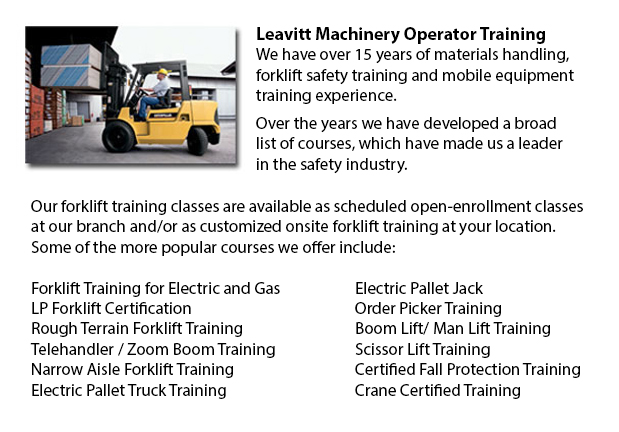
Kingston Forklift Training Schools - Forklift Training Schools - For The Protection Of Your Employees
Are you searching for a job as a driver of a forklift? Our regulatory-compliant mobile equipment operator training provides instruction in kinds of lift trucks, pre-shift inspection, fuel types and dealing with fuels, and safe operation of a lift truck. Practical, hands-on training assists individuals participating in obtaining fundamental operational skills. Program content consists of current regulations governing the operation of forklifts. Our proven forklift Schools are intended to provide training on these kinds of trucks: narrow isle forklift, counterbalanced forklift and powered pallet truck.
Whilst the lift truck is in operation, do not raise or lower the forks. Loads should not extend above the backrest. This is due to the danger of the load sliding back in the direction of the operator. Check for overhead obstructions and ensure there is enough clearance prior to raising a load. Stay away from overhead power lines. When the load is lifted straight up, tilt it slightly back.
The lift truck is less steady when a load is in a raised position. Make certain that no one ever walks under the elevated fork. The operator must never leave the lift truck when the load is raised.
The forks should be level when handling pallets, and high enough to extend all the way into and below the load. The width of the forks must provide equal distribution of weight.
Before loading or unloading the truck, chock the wheels and set the brakes. Floors must be strong enough to support the weight of the load and the forklift combined. Fixed jacks could be installed in order to support a semi-trailer that is not coupled to a tractor. The entrance door height should clear the forklift height by a minimum of 5 cm. Edges of rail cars, ramps and docks must be marked and avoid them.
-
Narrow Aisle Forklift / Order Picker Training / Electric Pallet Jack / Electric Pallet Truck Training in Kingston
A pallet lift is a piece of equipment dedicated in the moving of pallets of various dimensions and weights. They might be utilized as an accessory for forklifts, cranes and other styles of heavy machinery or be applied on their own. Pallet lifts are... More -
Kingston Forklift Training School
Kingston Forklift Training School - Forklift Training School - Industry and federal regulators have established the criteria for forklift safety training based on their existing regulations and standards. People wishing to operate a forklift must fin... More -
Kingston Scissor Lift Certification
Kingston Scissor Lift Certification - Scissor lift platforms are utilized at work locations to enable tradespeople - such as iron workers, welders and masons - to reach their work. Making use of a scissor lift platform is usually secondary to their t... More -
Kingston Boom Lift Safety Training
Kingston Boom Lift Safey Training - Boom lifts are a type of elevated work platform or aerial lifting device that are normally utilized in warehousing, construction and industry. Boom lifts could be made use of in practically whichever environment du... More -
Kingston Fall Protection Ticket
Kingston Fall Protection Ticket - Fall-related incidents are the number one reason of death in the construction business. The possibility for fall accidents very much increases based upon the type of work which is being accomplished within your workp... More -
Telehandler Training in Kingston
Telescopic handlers normally called telehandlers for short, are an extremely popular piece of heavy construction machinery. They are widely utilized in the construction and agricultural trades. These machines have farthest reaching ability and are ab... More -
Kingston Warehouse Forklift Training Programs
Kingston Warehouse Forklift Training Programs - Warehouses could either be retail, industrial or commercial facilities, functioning from bulk product retailing to product distribution services. Regardless of the type of warehouse, personnel inside wa... More -
Kingston Heavy Equipment Ticket
Kingston Heavy Equipment Ticket - Depending on the nature of the job at hand, the kind of construction machinery that a heavy equipment operator utilizes varies. Every type of equipment is built to do particular jobs in the most effective method comm... More

Forklift Certification Kingston
TOLL FREE: 1-888-254-6157
Kingston, Ontario
forkliftcertificationkingston.com
Email Us
About Us


